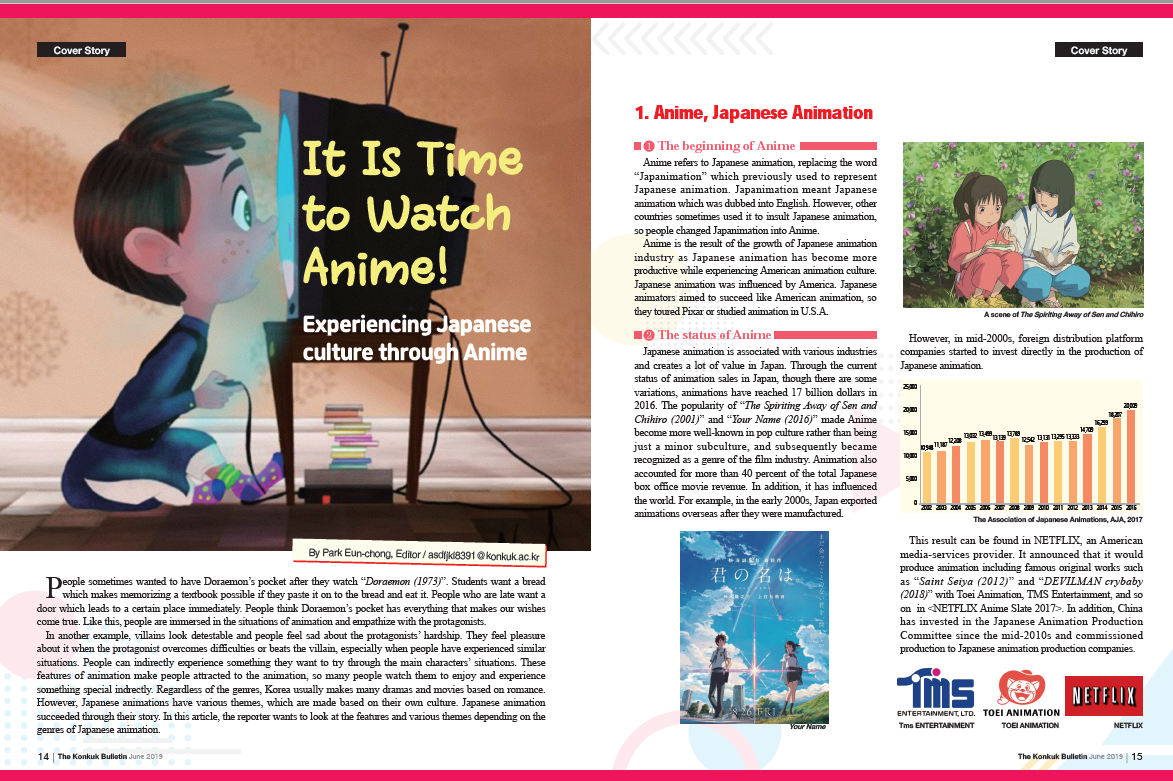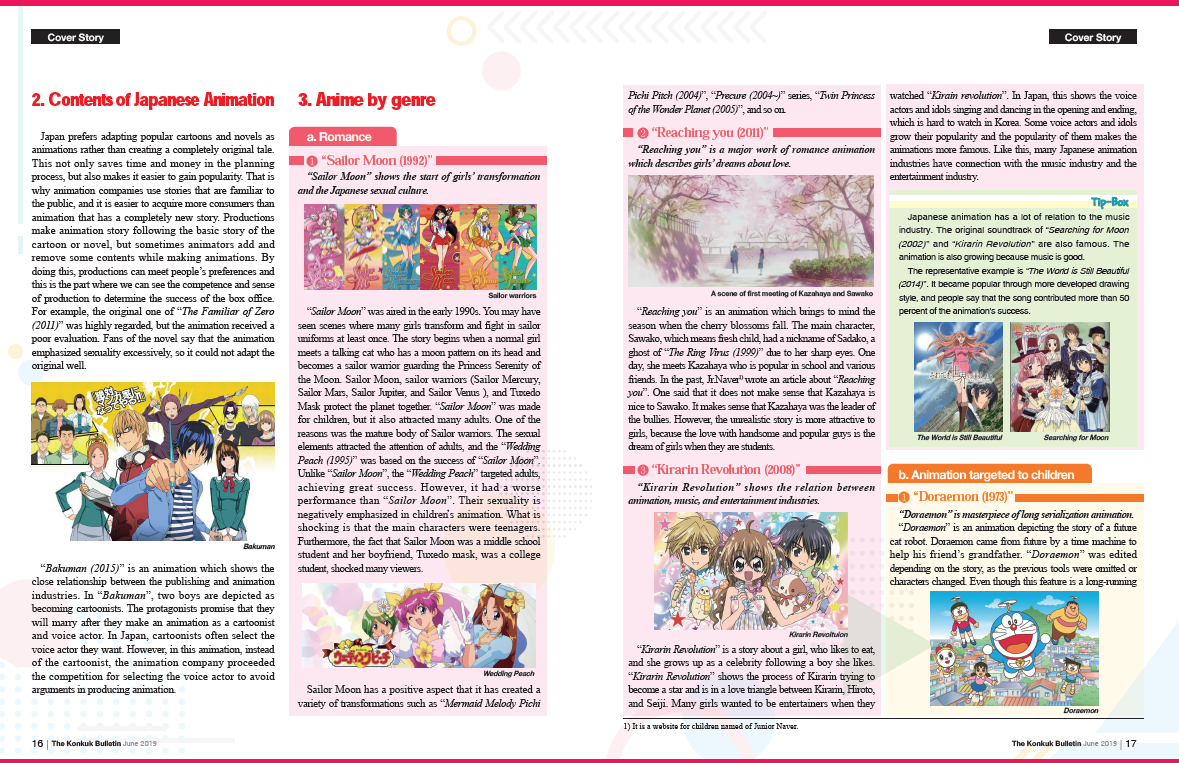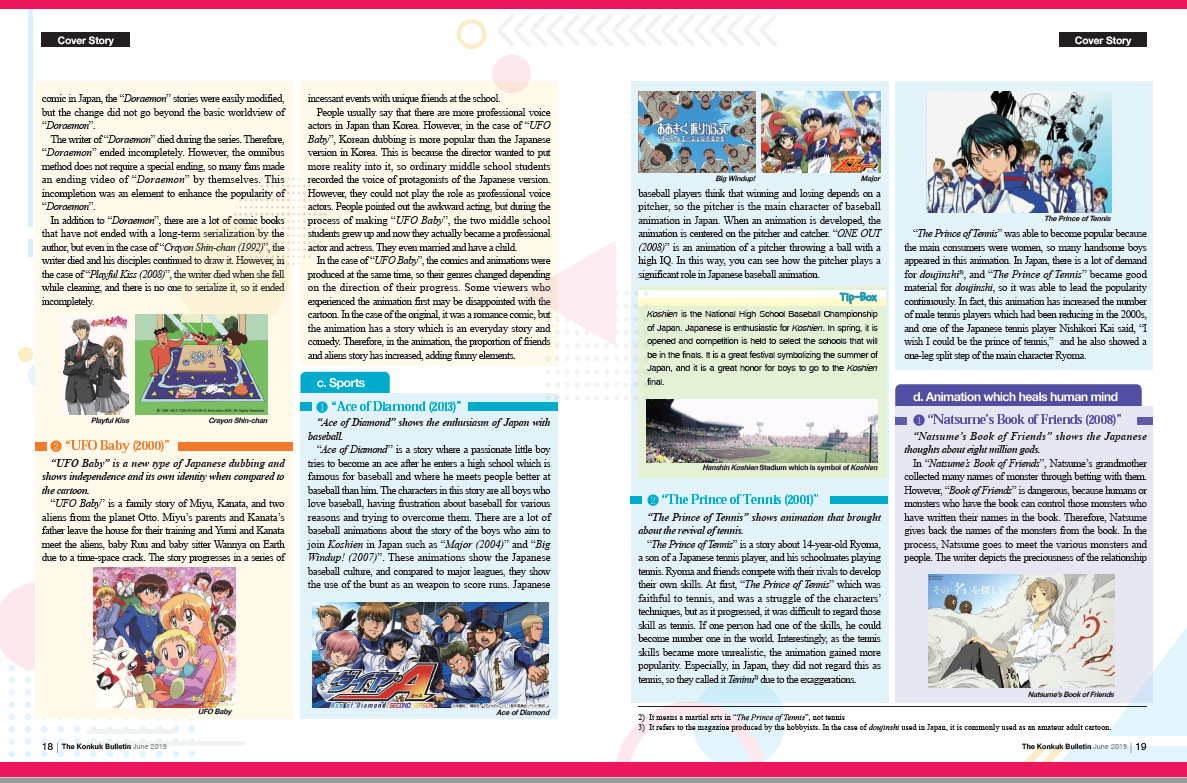Experiencing Japanese culture through Anime




People sometimes wanted to have Doraemon’s pocket after they watch “Doraemon (1973)”. Students want a bread which makes memorizing a textbook possible if they paste it on to the bread and eat it. People who are late want a door which leads to a certain place immediately. People think Doraemon’s pocket has everything that makes our wishes come true. Like this, people are immersed in the situations of animation and empathize with the protagonists.
In another example, villains look detestable and people feel sad about the protagonists’ hardship. They feel pleasure about it when the protagonist overcomes difficulties or beats the villain, especially when people have experienced similar situations. People can indirectly experience something they want to try through the main characters’ situations. These features of animation make people attracted to the animation, so many people watch them to enjoy and experience something special indrectly. Regardless of the genres, Korea usually makes many dramas and movies based on romance. However, Japanese animations have various themes, which are made based on their own culture. Japanese animation succeeded through their story. In this article, the reporter wants to look at the features and various themes depending on the genres of Japanese animation.
1. Anime, Japanese Animation
❶ The beginning of Anime
Anime refers to Japanese animation, replacing the word “Japanimation” which previously used to represent Japanese animation. Japanimation meant Japanese animation which was dubbed into English. However, other countries sometimes used it to insult Japanese animation, so people changed Japanimation into Anime.
Anime is the result of the growth of Japanese animation industry as Japanese animation has become more productive while experiencing American animation culture. Japanese animation was influenced by America. Japanese animators aimed to succeed like American animation, so they toured Pixar or studied animation in U.S.A.
❷ The status of Anime
Japanese animation is associated with various industries and creates a lot of value in Japan. Through the current status of animation sales in Japan, though there are some variations, animations have reached 17 billion dollars in 2016. The popularity of “The Spiriting Away of Sen and Chihiro (2001)” and “Your Name (2016)” made Anime become more well-known in pop culture rather than being just a minor subculture, and subsequently became recognized as a genre of the film industry. Animation also accounted for more than 40 percent of the total Japanese box office movie revenue. In addition, it has influenced the world. For example, in the early 2000s, Japan exported animations overseas after they were manufactured.
However, in mid-2000s, foreign distribution platform companies started to invest directly in the production of Japanese animation.
This result can be found in NETFLIX, an American media-services provider. It announced that it would produce animation including famous original works such as “Saint Seiya (2012)” and “DEVILMAN crybaby (2018)” with Toei Animation, TMS Entertainment, and so on in <NETFLIX Anime Slate 2017>. In addition, China has invested in the Japanese Animation Production Committee since the mid-2010s and commissioned production to Japanese animation production companies.
2. Contents of Japanese Animation
Japan prefers adapting popular cartoons and novels as animations rather than creating a completely original tale. This not only saves time and money in the planning process, but also makes it easier to gain popularity. That is why animation companies use stories that are familiar to the public, and it is easier to acquire more consumers than animation that has a completely new story. Productions make animation story following the basic story of the cartoon or novel, but sometimes animators add and remove some contents while making animations. By doing this, productions can meet people’s preferences and this is the part where we can see the competence and sense of production to determine the success of the box office. For example, the original one of “The Familiar of Zero (2011)” was highly regarded, but the animation received a poor evaluation. Fans of the novel say that the animation emphasized sexuality excessively, so it could not adapt the original well.
“Bakuman (2015)” is an animation which shows the close relationship between the publishing and animation industries. In “Bakuman”, two boys are depicted as becoming cartoonists. The protagonists promise that they will marry after they make an animation as a cartoonist and voice actor. In Japan, cartoonists often select the voice actor they want. However, in this animation, instead of the cartoonist, the animation company proceeded the competition for selecting the voice actor to avoid arguments in producing animation.
3. Anime by genre
a. Romance
❶ “Sailor Moon (1992)”
“Sailor Moon” shows the start of girls’ transformation and the Japanese sexual culture.
“Sailor Moon” was aired in the early 1990s. You may have seen scenes where many girls transform and fight in sailor uniforms at least once. The story begins when a normal girl meets a talking cat who has a moon pattern on its head and becomes a sailor warrior guarding the Princess Serenity of the Moon. Sailor Moon, sailor warriors (Sailor Mercury, Sailor Mars, Sailor Jupiter, and Sailor Venus ), and Tuxedo Mask protect the planet together. “Sailor Moon” was made for children, but it also attracted many adults. One of the reasons was the mature body of Sailor warriors. The sexual elements attracted the attention of adults, and the “Wedding Peach (1995)” was based on the success of “Sailor Moon”. Unlike “Sailor Moon”, the “Wedding Peach” targeted adults, achieving great success. However, it had a worse performance than “Sailor Moon”. Their sexuality is negatively emphasized in children’s animation. What is shocking is that the main characters were teenagers. Furthermore, the fact that Sailor Moon was a middle school student and her boyfriend, Tuxedo mask, was a college student, shocked many viewers.
Sailor Moon has a positive aspect that it has created a variety of transformations such as “Mermaid Melody Pichi Pichi Pitch (2004)”, “Precure (2004~)” series, “Twin Princess of the Wonder Planet (2005)”, and so on.
❷ “Reaching you (2011)”
“Reaching you” is a major work of romance animation which describes girls’ dreams about love.
“Reaching you” is an animation which brings to mind the season when the cherry blossoms fall. The main character, Sawako, which means fresh child, had a nickname of Sadako, a ghost of “The Ring Virus (1999)” due to her sharp eyes. One day, she meets Kazahaya who is popular in school and various friends. In the past, Jr.Naver1) wrote an article about “Reaching you”. One said that it does not make sense that Kazahaya is nice to Sawako. It makes sense that Kazahaya was the leader of the bullies. However, the unrealistic story is more attractive to girls, because the love with handsome and popular guys is the dream of girls when they are students.
❸ “Kirarin Revolution (2008)”
“Kirarin Revolution” shows the relation between animation, music, and entertainment industries.
“Kirarin Revolution” is a story about a girl, who likes to eat, and she grows up as a celebrity following a boy she likes. “Kirarin Revolution” shows the process of Kirarin trying to become a star and is in a love triangle between Kirarin, Hiroto, and Seiji. Many girls wanted to be entertainers when they watched “Kirain revolution”. In Japan, this shows the voice actors and idols singing and dancing in the opening and ending, which is hard to watch in Korea. Some voice actors and idols grow their popularity and the popularity of them makes the animations more famous. Like this, many Japanese animation industries have connection with the music industry and the entertainment industry.
b. Animation targeted to children
❶ “Doraemon (1973)”
“Doraemon” is masterpiece of long serialization animation.
“Doraemon” is an animation depicting the story of a future cat robot. Doraemon came from future by a time machine to help his friend’s grandfather. “Doraemon” was edited depending on the story, as the previous tools were omitted or characters changed. Even though this feature is a long-running comic in Japan, the “Doraemon” stories were easily modified, but the change did not go beyond the basic worldview of “Doraemon”.
The writer of “Doraemon” died during the series. Therefore, “Doraemon” ended incompletely. However, the omnibus method does not require a special ending, so many fans made an ending video of “Doraemon” by themselves. This incompletion was an element to enhance the popularity of “Doraemon”.
In addition to “Doraemon”, there are a lot of comic books that have not ended with a long-term serialization by the author, but even in the case of “Crayon Shin-chan (1992)”, the writer died and his disciples continued to draw it. However, in the case of “Playful Kiss (2008)”, the writer died when she fell while cleaning, and there is no one to serialize it, so it ended incompletely.
❷ “UFO Baby (2000)”
“UFO Baby” is a new type of Japanese dubbing and shows independence and its own identity when compared to the cartoon.
"UFO Baby” is a family story of Miyu, Kanata, and two aliens from the planet Otto. Miyu’s parents and Kanata’s father leave the house for their training and Yumi and Kanata meet the aliens, baby Ruu and baby sitter Wannya on Earth due to a time-space crack. The story progresses in a series of incessant events with unique friends at the school.
People usually say that there are more professional voice actors in Japan than Korea. However, in the case of “UFO Baby”, Korean dubbing is more popular than the Japanese version in Korea. This is because the director wanted to put more reality into it, so ordinary middle school students recorded the voice of protagonists of the Japanese version. However, they could not play the role as professional voice actors. People pointed out the awkward acting, but during the process of making “UFO Baby”, the two middle school students grew up and now they actually became a professional actor and actress. They even married and have a child.
In the case of “UFO Baby”, the comics and animations were produced at the same time, so their genres changed depending on the direction of their progress. Some viewers who experienced the animation first may be disappointed with the cartoon. In the case of the original, it was a romance comic, but the animation has a story which is an everyday story and comedy. Therefore, in the animation, the proportion of friends and aliens story has increased, adding funny elements.
c. Sports
❶ “Ace of Diamond (2013)”
“Ace of Diamond” shows the enthusiasm of Japan with baseball.
“Ace of Diamond ” is a story where a passionate little boy tries to become an ace after he enters a high school which is famous for baseball and where he meets people better at baseball than him. The characters in this story are all boys who love baseball, having frustration about baseball for various reasons and trying to overcome them. There are a lot of baseball animations about the story of the boys who aim to join Koshien in Japan such as “Major (2004)” and “Big Windup! (2007)”. These animations show the Japanese baseball culture, and compared to major leagues, they show the use of the bunt as an weapon to score runs. Japanese baseball players think that winning and losing depends on a pitcher, so the pitcher is the main character of baseball animation in Japan. When an animation is developed, the animation is centered on the pitcher and catcher. “ONE OUT (2008)” is an animation of a pitcher throwing a ball with a high IQ. In this way, you can see how the pitcher plays a significant role in Japanese baseball animation.
❷ “The Prince of Tennis (2001)”
“The Prince of Tennis” shows animation that brought about the revival of tennis.
“The Prince of Tennis” is a story about 14-year-old Ryoma, a son of a Japanese tennis player, and his schoolmates playing tennis. Ryoma and friends compete with their rivals to develop their own skills. At first, “The Prince of Tennis” which was faithful to tennis, and was a struggle of the characters’ techniques, but as it progressed, it was difficult to regard those skill as tennis. If one person had one of the skills, he could become number one in the world. Interestingly, as the tennis skills became more unrealistic, the animation gained more popularity. Especially, in Japan, they did not regard this as tennis, so they called it Teninu2) due to the exaggerations.
“The Prince of Tennis” was able to become popular because the main consumers were women, so many handsome boys appeared in this animation. In Japan, there is a lot of demand for doujinshi3), and “The Prince of Tennis” became good material for doujinshi, so it was able to lead the popularity continuously. In fact, this animation has increased the number of male tennis players which had been reducing in the 2000s, and one of the Japanese tennis player Nishikori Kai said, “I wish I could be the prince of tennis,” and he also showed a one-leg split step of the main character Ryoma.
d. Animation which heals human mind
❶ “Natsume’s Book of Friends (2008)”
“Natsume’s Book of Friends” shows the Japanese thoughts about eight million gods.
In “Natsume’s Book of Friends”, Natsume’s grandmother collected many names of monster through betting with them. However, “Book of Friends” is dangerous, because humans or monsters who have the book can control those monsters who have written their names in the book. Therefore, Natsume gives back the names of the monsters from the book. In the process, Natsume goes to meet the various monsters and people. The writer depicts the preciousness of the relationship by portraying the story of the human who lives only for 100 years and the monsters who live for eternity. Subject of this animation is monsters. This reflects the culture of Japan, which believes all things can be a god. Japan has a lot of animations related to yin and yang4). All of these are animations based on Japan’s eight million gods. These animations emphasize human’s evil not only by thinking about Japanese gods, but also by introducing monsters and humans beings simultaneously in the animation. “Shonen Onyoji (2006)”, “Kamisama Kiss (2015)”, and so on are based on these ideas.
4. Conclusion
Japanese animations have succeeded through high immersion and detailed depiction. Japan has made their animation by learning American animation’s success factor and adding their own culture to animations. Therefore, Japanese animations contain Japanese culture and thoughts. Animations which targeted diverse viewers also can get their fans and make their own genre. Many writers can express their attitude in their animation because Japanese animations contain a variety of topics. These Japanese animations develop with other industries. The animation industry is related to the music industry, publishing industry, and so on. Japan is making various goods and figures with animated characters. At first, many people regarded Otaku as a person with obsessive interest, particularly in animations and comics. Nowadays, the concept of kidult6) has appeared and consumed them. People regard collecting animated goods and figures as a hobby, and they recognize Otaku as a person who has a kind of preference. These situations make a positive recognition about Otaku. Nowadays, people say Japanese animations are not only orientations but also records of history and a window which shows the world to people. In the future, Japanese animations will play a role as a form of entertainment, transmitter, and producer.

